 USA – 46 battleships
USA – 46 battleshipsWW1 US Battleships:
USS Maine | USS Texas | Indiana class | USS Iowa | Kearsage class | Illinois class | Maine class | Virginia class | Connecticut class | Mississippi class | South Carolina class | Delaware class | Florida class | Arkansas class | New York class | Nevada class | Pennsylvania class | New Mexico class | Tennessee class | Colorado class | South Dakota class | Lexington classThe development of WW1 era American battleship really started with the USS Texas in 1890. Despite these humble beginnings, American policy to leave the traditional isolationism, combined to the ideas of Mahan and Sims, the (strong) will of President T. Roosevelt made for a rapid rise, from the obscurity to the world’s third rank in 1914 and second in 1918. Battleships were the cornerstone of the Navy, a powerful fleet which was split between two oceans but never seriously tested before 1941, by then the world’s largest battleships force.
From Ironclads to Dreadnoughts: 1862 to 1908
Until there was the need to project power on the oceans, and ending American isolationist policy, the rise of the “Hawks” at the White House and Congress, which culminated with the 1898 war and the “great white fleet” afterwards. the American civil war was the first time the ‘old navy’ experimented with armour at sea since the Demologos in 1814, a paddle-propelled wooden-clad.
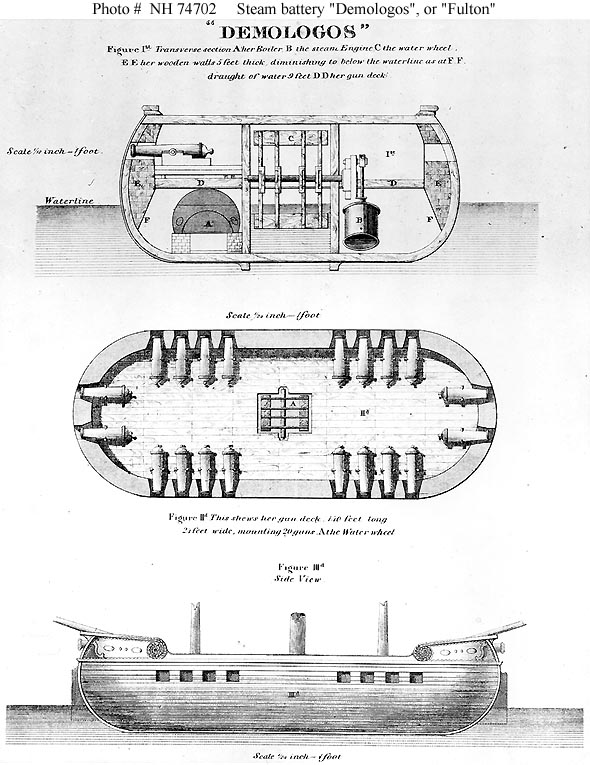
Fulton’s Demologos, created to counter the mighty Royal Navy, the granddaddy of all USN Battleships
At first, to answer the Confederate threat of the USS Virginia ex-Merrimack. With the USS Monitor, the Union Fleet deployed a ships way ahead of her time, with a revolving turret instead of broadside guns, minimalistic superstructure to protect itself, armour all around and steam only. The first became so famous it gave its name to a genre which knew success under various forms until the Vietnam War.
WW1 American monitors
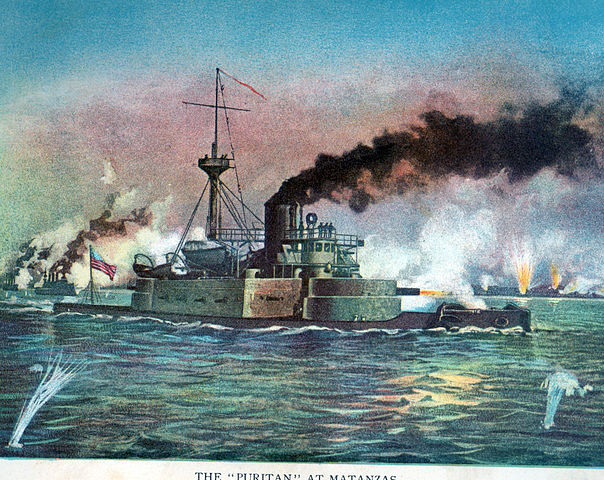
There were still a dozen of Monitors in service during the great war, used as coastal defence vessels and gun platforms to be deployed in areas that required their presence on the Mississippi and some of its tributaries, close to home, even in the Caribbean or South American waters.
Still on the lists were the USS Puritan (1882), Amphitrite class (1883), and USS Monterey (1891).

USS Amphitrite
The most recent were the the four Arkansas-class monitors (USS Arkansas, Nevada, Florida, Wyoming) launched in 1900 and completed in 1902-03, the culmination of this type started in 1863. They are somewhat designed as the equivalents of standard battleships with only one turret and riverine capabilities. Their Mississippi “police” role became of little help as part of Roosevelt’s projected fleet. Nevertheless, the class was renamed BM7 to BM10 in 1909, and later Ozark, Tonopah, Talahassee, and Cheyenne to free the names for 1911 dreadnoughts. In 1914 they served as submarine refuellers along the coast.
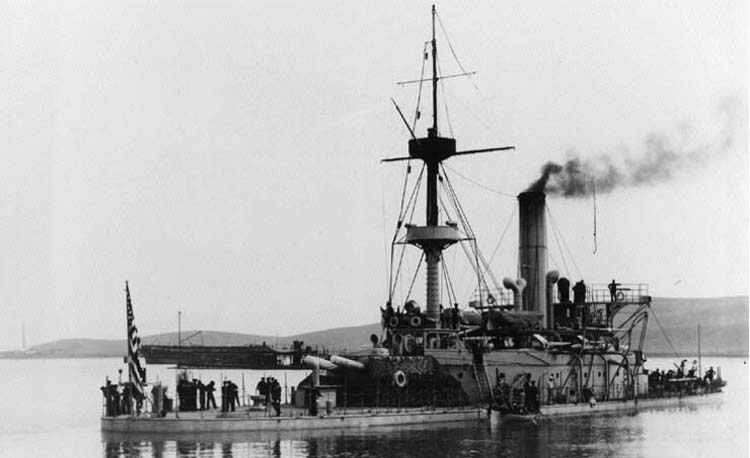
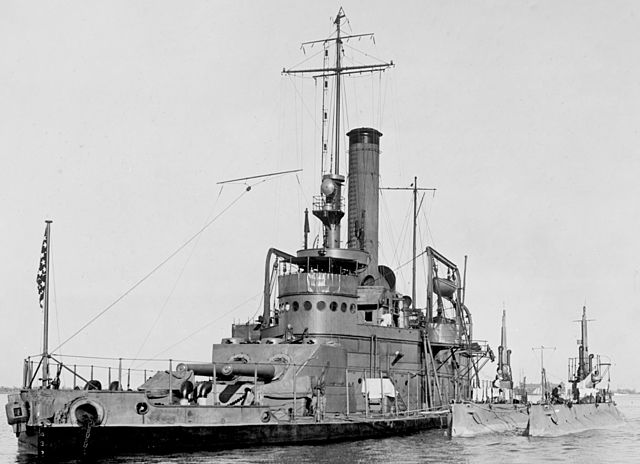
BM-9 ex-Florida at Hampton roads, tending submarines in 1917.
Specifications
Displacement: 3225t, 3600t FL
Dimensions: 77,75 x 15,24 x 3,81m
Propulsion: 1 RP steam engine, 4 boilers, 2400 hp. 12.5 knots max.
Armor: Barbettes 280 mm, Turret 250 mm, belt 280 mm
Crew: 220
Armament: 2 x 305 mm (1×2), 4 x 100 mm, 3 x 47 mm.
The New Navy’s first ironclads: 1890-1898
Historically, the USN (by then the Union Navy) started with Ironclads at the start of the civil: It was the New Ironsides, made in response to the word that the Confederates were converting the Merrimack as their first ironclad, the Virginia. However the latter was a riverine casemate ship while the second was an authentic sea-going Ironclad comparable to those in service with the French and British Navies.
However soon, the nature of the operations dictated the use of a variety of riverine armoured ships, and the development of the Monitor. Therefore next was the USS Dictator, first sea-going monitor of the USN (1863). After the war ended, the USN fell into an era of budget constraints which saw the “old navy” disappearing.
The “New Navy” program of the 1880s saw the first two ships authorized as “coast defense battleships”, USS Maine was constructed as a ‘cruiser’ rather than a battleship, perhaps to make it “less painful” on the Congress. The USS Texas (BB1) became the very first American battleship ever, so first also to be detailed in this post. But again, the Congress in its majority was certainly not willing to go this way. The “hawks” were not there yet and Mahan’s voice was still inaudible to the majority.
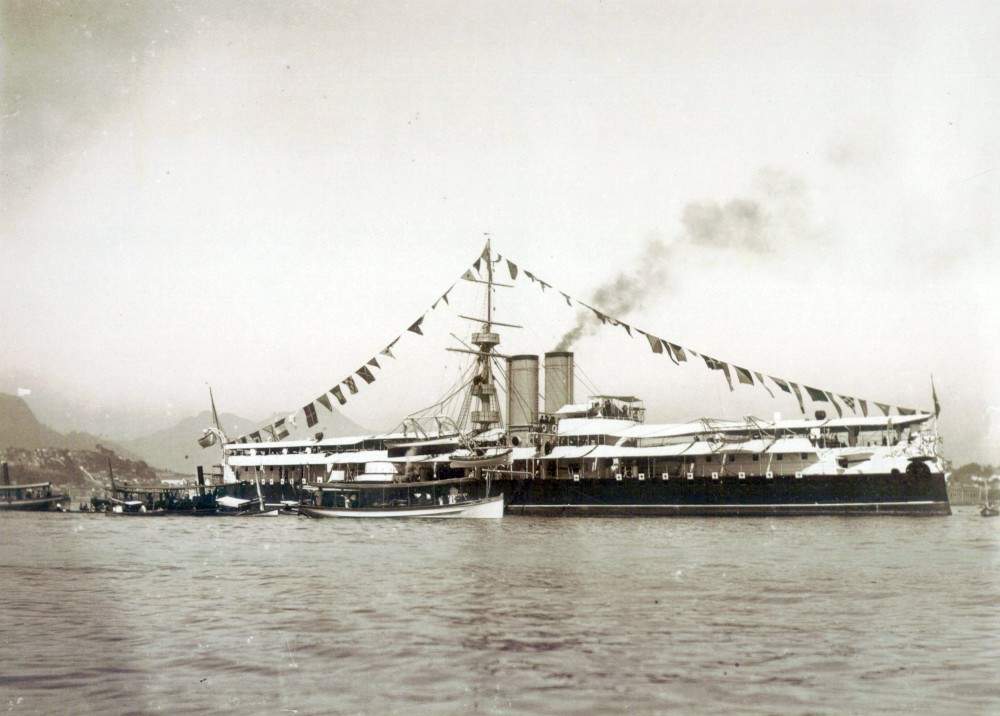
The threat posed by the Brazilian ironclad Riachuelo, by then the most powerful warship on the continent, ‘woke up’ the US admiralty and Congress. The ‘New Navy’ was born.
It would take Brazil’s delivery of the battleship Riachuelo in 1883 and rival Argentina and Chile own acquisitions to question US Maritime power on the western hemisphere. The USS Texas was then authorized by the congress in 1886 only to balance that gap “at home”, but by doing this, the “New Navy” has a start. More so, to be more easily accepted, the Texas was seen as a coast guard armored ship, with just two 12-in guns, rather than the usual four on European battleships, twice that tonnage and long range.
The USS Maine was even planned as an “armoured cruiser” and indeed only carried two twin 10 in (254 mm) guns but was very well armoured, between 10 and 12 in. But her construction time was nine year. So when she was in service, ACR-1 was hopelessly obsolete.
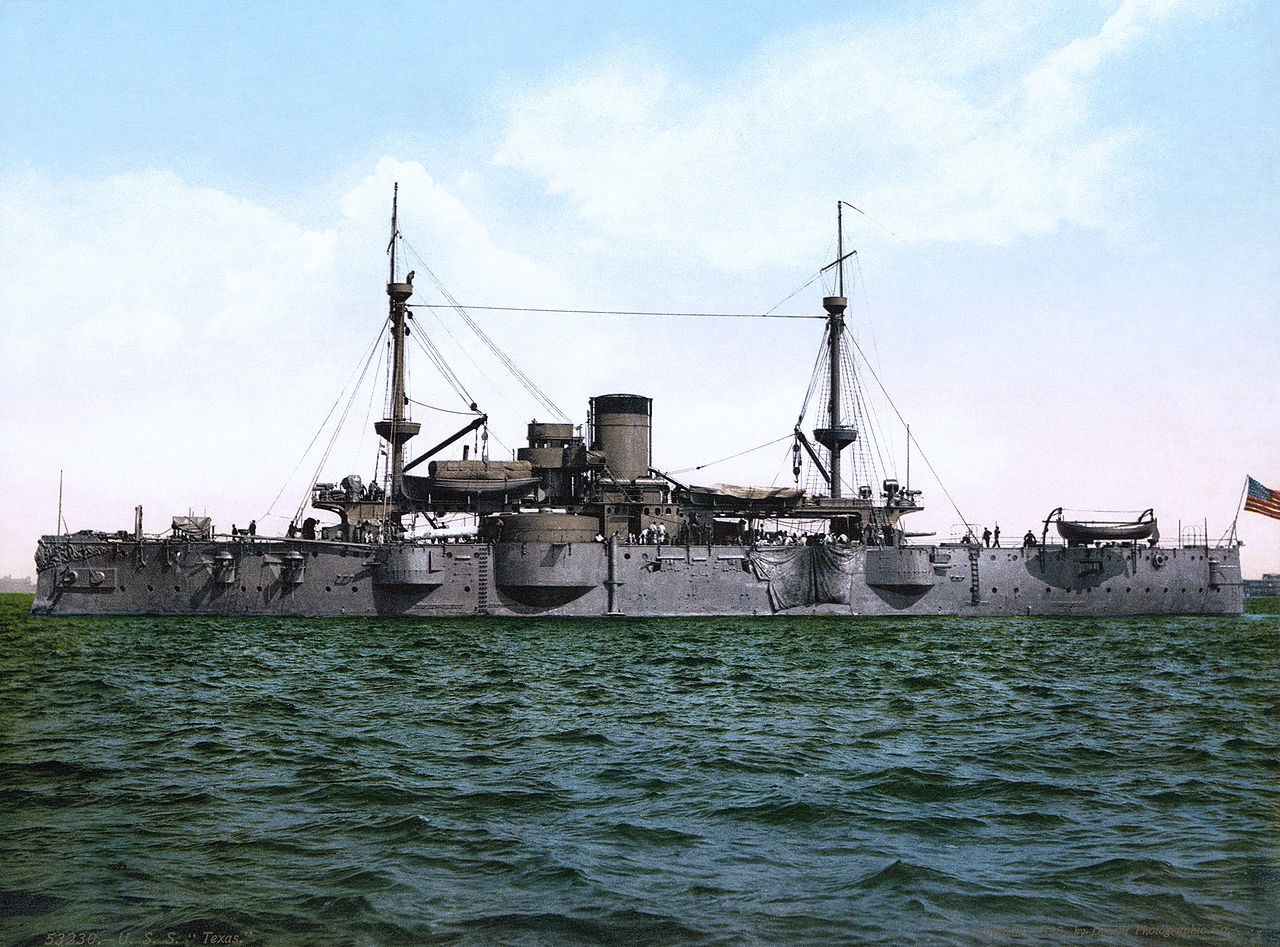
The coastal nature of USS Texas in 1890 was a prudent step forward, still compatible with the isolationist policy of the United States.
The “great white fleet”‘s pre-dreadnoughts 1907-1909
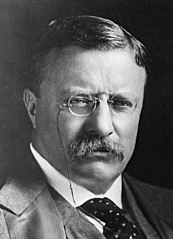 The ‘Great White Fleet’, referring to the color of the hulls, became the popular nickname of the powerful United States Navy battle fleet in 1906. This fleet started a journey around the globe started on 16 December 1907, until to 22 February 1909. This came as an order of the then United States President, Theodore Roosevelt. Like any individual ships of the time, the mission was a classic “good will tour”, each ship acting as an ambassador and part of the territory of the country at sea. Courtesy visits multiplied whereas was displayed the brand new U.S. naval power to the world, in full regalia.
The ‘Great White Fleet’, referring to the color of the hulls, became the popular nickname of the powerful United States Navy battle fleet in 1906. This fleet started a journey around the globe started on 16 December 1907, until to 22 February 1909. This came as an order of the then United States President, Theodore Roosevelt. Like any individual ships of the time, the mission was a classic “good will tour”, each ship acting as an ambassador and part of the territory of the country at sea. Courtesy visits multiplied whereas was displayed the brand new U.S. naval power to the world, in full regalia.
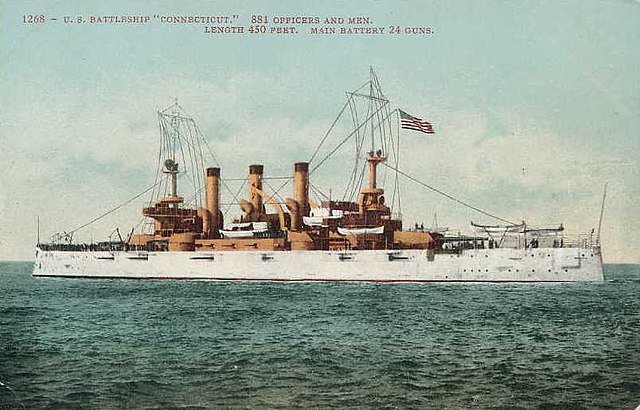
Apart naval reviews, Jubilee and coronations naval parades which were localized, the “great white fleet” was the first time an entire battle fleet was at sea in peace time that way. However there has been previous events of similar scope: In 1891, a large French fleet visited Kronstadt, Russia, to pressure negotiations. The Germans were invited to send their best ships as well in 1902 to New York and these years, courtesy visits frequently implied many warships of the same Nations, entire squadrons. Another USN squadron arrived in North Africa by 1906, to settle a diplomatic crisis between France and Germany over Morocco: Eight USN battleships entered the Mediterranean Sea to stay.
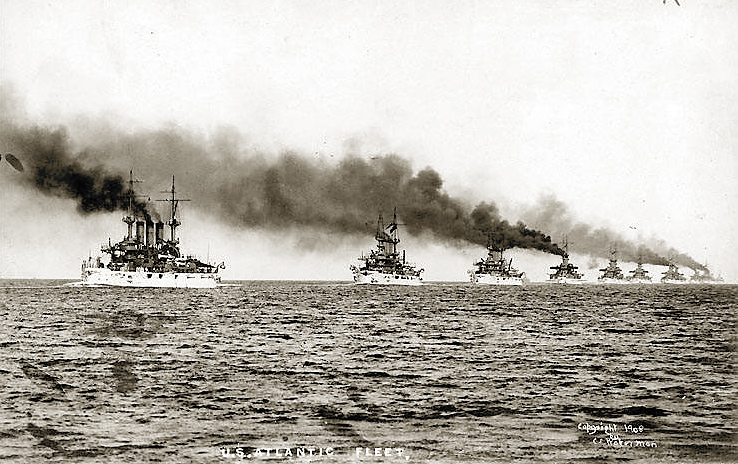
This fleet was composed of the 16 battleships available, divided into two squadrons, and escorts ranging from the latest armoured cruisers to older protected cruisers a tenth of their displacement. Roosevelt sought to demonstrate what the American military achieved, completing its status as a blue-water naval superpower, only comparable to the top five. Another objective was to enforce treaties and protect overseas possessions of the US, like the Philippines, recently acquired, against any naval ambitions by a regional power. The United States Congress secured funds for the ships as well as for the tour. The Great White Fleet was also sent in the pacific, showing muscles to an growingly ambitious and overconfident Japan after the victory at Tsushima.
The fleet displayed very disparate battleships however, those of the early generation, barely more than glorified coastal capital ships such as the Maine, Illinois and USS Kearsage, in complete contrast to the post-1898 true oceanic vessels such as the Virginia and Connecticut, displaying the “highest practicable speed and greatest radius of action”, according to the Congress. The trip was considerable: As the Panama Canal was not yet completed, the fleet has to veer south and go through the dreaded Cape Horn.
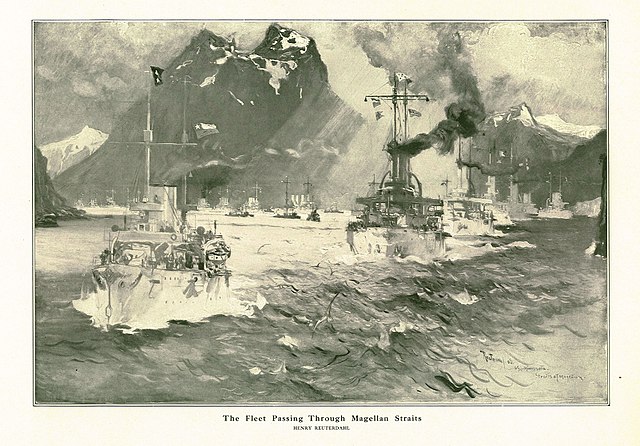
The trip comprised three separate cruises. The first leg started from Hampton Roads, Virginia on 16 December 1907. Next stop was Port of Spain, Trinidad, Rio de Janeiro, Brazil, in January 1908, Punta Arenas, Chile on 1 February 1908, Callao, Peru, Magdalena Bay, Mexico and final leg to San Francisco, California on 6 May 1908. On 23 May 1908 the 16-battleships Fleet started from Puget Sound, visiting six Washington state ports: Bellingham, Bremerton, Port Angeles, Port Townsend, Seattle and Tacoma. Arrival occurred at Seattle on 23 May, and the feet departed again on 27 May 1908.
The third leg was probably the most impressive, starting from San Francisco on 7 July 1908, crossing the Pacifi to Honolulu, Hawaii, Auckland, Sydney, Melbourne, Victoria, Albany in Australia, Manila in the Philippine Islands, Yokohama (Japan), Amoy (China). The fourth leg and return home passed through Colombo, Ceylon on 13 December 1908, Suez in Egypt (3 January 1909) Gibraltar and back to Hampton Roads in Virginia.
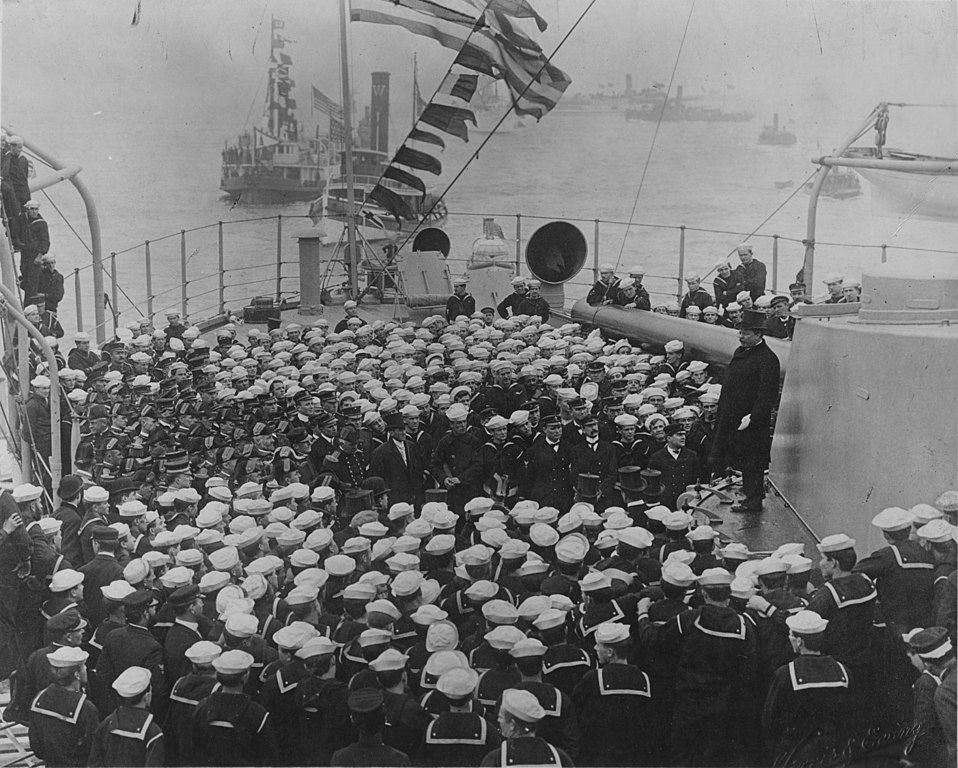
It should be noted that the trip was not just an exercize in displomatic show of force, it also underlines many issues with the USN and battleships handling. The cruise provided practical experience in sea duty, conformed the viability of US warships for long-range operations but also covered potential flaws, in gunnery engagement and concrete battle fleet action. It perhaps even helped obscure these deficiencies until WW1 broke out. The ships indeed shown excessive draft, low armor belts, large turret openings with exposed ammunition hoists that could have been disastrous in any engagement. Also, it was underlined the fleet’s dependence on foreign colliers, the need for coaling stations and auxiliary ships.
Fortunately due to the nature of naval warfare and tremendous disparities in 1917, the USN mighty battle fleet went mostly inactive and the 1922 Washington treaty will send the whole ‘White Fleet’ to the scrapyard, never having fired a short in anger, but for the few veterans of the Spanish-American war.
Development of the American dreadnoughts
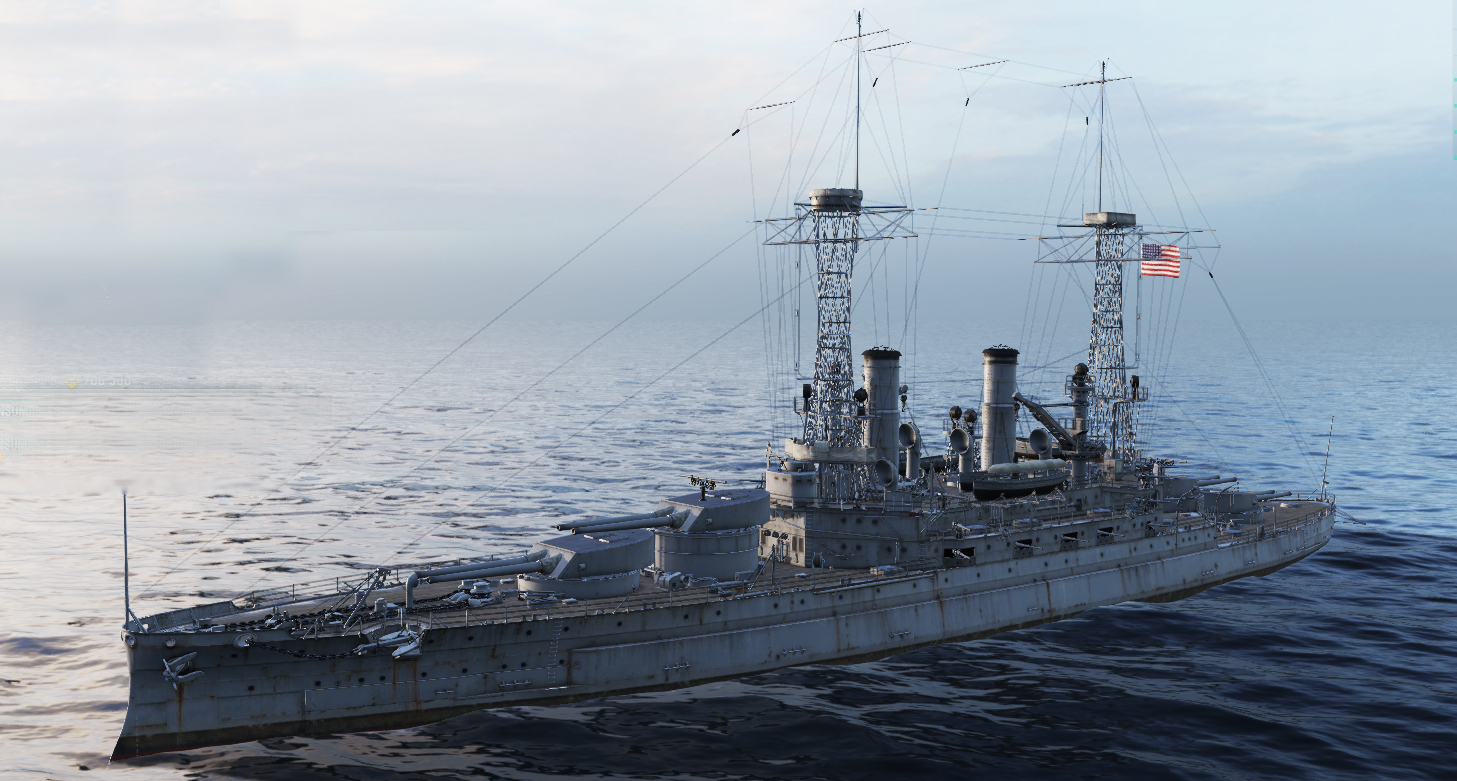
WoW’s rendition of USS South Carolina
When the great white fleet finally came home in 1909, the face of the USN was already changing: A new plan has been ordered already, placing the new dreadnought in the center of American naval shipbuilding. The “great white fleet” made entirely of pre-dreadnoughts literally came home to discover a brand new fleet in construction. In December 1909, the first two were in completion, the South Carolina class. Already the next were in construction, the Delaware and Florida.
This did not came out of the blue and without resistance. Indeed the concept was already “in the air” in 1903 shared by most admiralties of the time. It was hardly confirmed in 1905 after Tsushima, whereas the HMS Dreadnought was in construction. Indeed, many still thought battles were to be fought at relatively close range with many medium to small, fast-firing guns. However American naval theorists proposed to mount an homogeneous battery of large guns, as more effective.
But this evolution was not only about all-big guns. The last cruise showed that an increased freeboard forward and in general spray-reducing measures like the elimination of billboards for anchors and gun sponsons would be more effective. The hulls therefore needed to be higher, roomier. Increases in beam and overall size seemed logical, but only the Wyoming class was designed truly with the reports of the great white fleet in mind.
The years between 1903 and 1907 (when the South Carolina was ordered) indeed excluded the great white fleet cruise, but was dedicated to naval thinking, and the year 1905 bring too many additional data to the table, over firepower and distances.
The first publication to disrupt popular ideas about gunnery was the Naval Institute’s Proceedings magazine in 1902. It devoted large article to expose theoretical improvements in battleship design. 1903 Jane’s famous article by Cuniberti only confirmed the trend, into a more senstive package. Enthusiastic Lieutenant Matt H. Signor already called for a ship with a full battery of 13-inch (330 mm) cobined with 10-inch (254 mm)/40 caliber guns in four triple turrets, probably with the lighter caliber in superfiring positions. This very unusual solution was never adopted but superfiring combination of twin and triple turrets of the same caliber were found satisfactory eight years later (USS Nevada). The article was heavily commented by William M. Folger, Professor P. R. Alger and naval constructor David W. Taylor—an up-and-coming officer (future head of Construction and Repair (C&R)). The debate was launched.
The discussion ended with a proposal for a more realistic and feasible eight 12-inch guns in four twin turrets arrangement. Homer Poundstone later would be the one pushing towards a concrete monocaliber design. He wrote a letter in December 1902 to president T. Rooselevelt. He would also push his luck in the March and June 1903 editions of Proceedings, showing a battleship featuring no less than twelve 11-inch guns on a 19,330 long tons ship, eerily similar to Cunberti’s own proposal. Perhaps what drove more attention was the great interest shown by the Europeans in the new trend. Not to be undone, partisans of the new battleship concept advanced more arguments for their cause. At last, through Washington Irving Chambers, Poundstone’s ship was tested in war games by the Naval War College in the end of 1903, showing its clear superiority.
After this and that the battle of Tsushima shown naval battles at larger distances were possible, the General Board eventually sent a formal request in October 1903 to C&R for such a design. However in January the design asked for comprised four 12-inch guns and eight 10-inch guns as it was seen as doubtful large caliber turrets could be mounted on the broadsides. Therefore the design went intro traduction with the Connecticut class, later refined with the Mississippi class, both semi-dreadnought classes with a powerful secondary artillery.
There was indeed much resistance and conservatism between the C&R and General Board, to the dismay of Poundstone, until late 1904.
To break the bureaucratic stalemate, the latter crafted a new design, the “USS Possible” fitted with twelve 11-inch guns and displacing 19,330 long tons. With support of war hero admiral William Sims, the project went to the attentive ears of Teddy Roosevelt at last, which forced things up. The Congress in March 1905 at last passed a bill authorizing the Navy to construct the two new battleships. It was expressed their single caliber nature without a doubt this time. However perhaps not well informed of the new nature of it, the Congress only authorized a maximum tonnage limit of 16,000 long tons the same as the Connecticut !
This proved a serious blow to naval engineers which crafted the first American dreadnoughts on a tight and compromised design. The South carolina class was born. From then on, and with the HMS Dreadnought and more classes delivered from UK and Germany, the race was on. In 1909 at last, the Congress recognised the need for a more suitable tonnage, and this the first “true” American dreadnoughts were born: The Delaware class.
but back to the South Carolina. The engineer in charge of the design, Rear Admiral Washington L. Capps, did retrospectively an amazing job for turning the best possible broadside for such a cramped and limited package. Instead of delivering long ships with turrets placed on the same level (such as the Gangut or Dante Alighieri), he devised the first dreadnoughts with superfiring turrets. After all, the HMS Dreadnought and the following St Vincent and Bellophoron had all also same-level turrets. Superfiring turrets were a risky and very innovative solution, untested at that time, more so with such large turrets. The nightmarish prospects for all captains was the lack of stability and excessive rolling. Could such a battleship firing a full broadside could roll to a no-return point and capsize ? Could the rolling not stop soon enough in a naval engagement before the guns could be stabilized on target again ? This was uncharted territory.
Capps was able to cram this heavy broadside in a short hull (which recalls the future Viribus Unitis) but thick armor too. The only sacrifice was speed. There was no way of having the required space for the turbines and boilers required to produce more output than the Connecticuts. Indeed, space was further reduced by the turrets associated magazines which used a great amount of space. Boiler rooms were even moved inboard to make room for torpedo protection. It was difficult to curtail the numbers of boilers so the Bureau of Engineering came out with the idea of eliminating centerline bulkheads to free some space !
In retrospect, the South Carolina class sacrificed speed by squeezing some machinery in every inch available. Protection and armament were ok. But speed was inferior to British dreadnoughts and would have to wait for the next iteration.
The first battleship generation: Delaware to New York
Before the “standard types”, USN Battleship design followed an incremental path with some pros and cons and a lot of trials and errors. The next Delaware benefited from the perception from US Navy and Congress that the South carolina were actually quite inferior to the HMS Dreadnought. But this was untrue.
Only trading speed, the ships can bring to bear the same artillery in a broadside (the opposite british wing turret could not be used), and protection was of the same level. The greater tonnage authorized (19,000 tons) at least to gain the space needed for a proper powerplant. The extra size also allowed another turret, but the Americans chosed an all-axial configuration.
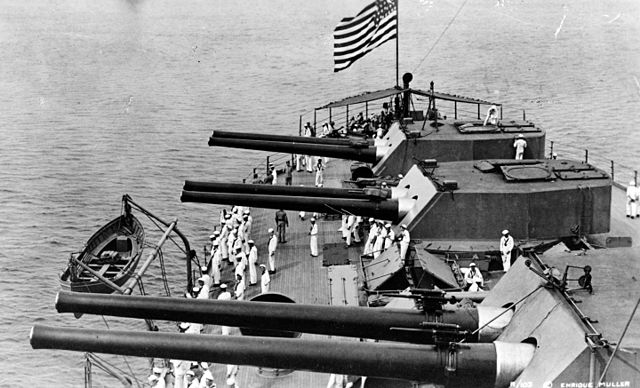
They would never ventured into wing turrets, whereas abaft a given position or in echelon. Therefore on the faster Delaware, the broadside counted one more pair of 12-in guns. The superfiring pair remained at the front, while the remaining three turrets aft were placed on the deck, on the same level. The only tradeoff of this was the proximity of the barrels to the roof of the next turret, preventing retreat fire without serious concussion from the last two turrets. In principle the innermost one was superfiring, the last two were back to back to prevent any attempt at a retreat fire. These battleships were first and foremost “battle line wagons”.
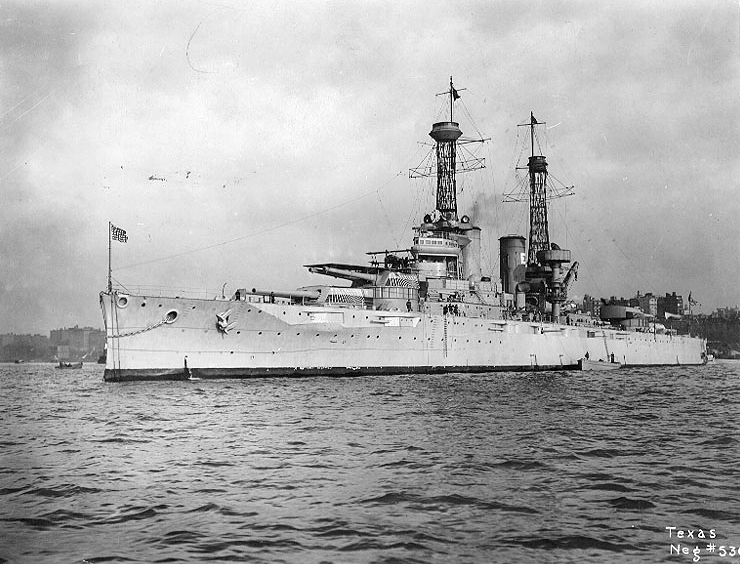
Wartime American dreadnoughts (1914-1920)
Before the Great War, the last American Dreadnought battleships were the New York class (1912), with a relatively conventional artillery, five axial twin turrets with 356 mm or 14 inches guns. USS New York and Texas were accepted for service in March and April 1914. On the other hand, rapid advances in armor design and optimization research led American engineers to venture into triple turrets rather than twins as well as the famous “all or nothing” armour scheme. The Nevada class (1914) was a sort of intermediary model, introducing a mix of twin and triple turrets like Italian battleships.
The idea was to preserve stability by placing the twins as superfiring turrets. But it was soon proved possible to mount heavier turrets, by making them lower, lighter and combine this with adding protection weight into the hull to lower the gravity point. The Nevada were also the first of tne new “standard battleships”, shering many charactistics, in displacement, protection, speed, even armour scheme. In detail, these were specified to have the same all-or-nothing armor scheme, all main guns on the centerline in fore and aft turrets, designed range of 8,000 nautical miles (15,000 km), top speed of 21 knots (39 km/h) and tactical turn radius of 700 yards.
The next Pennsylvania class (1915), still a prewar design to US perspective, were the first to introduce a main artillery entirely all in triple turrets, for twelve 14-in guns (356 mm) total, all axial, and capable of a broadside or six guns in chase and retreat.
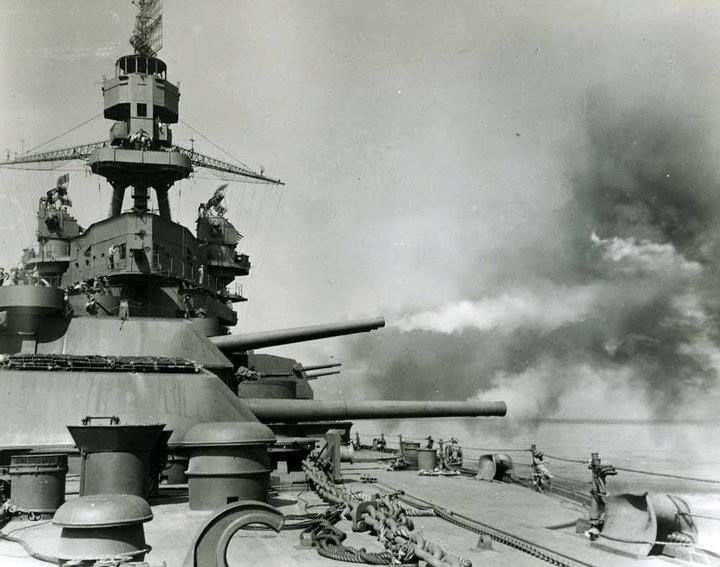
The following New Mexico class (1917) faithfully repeated this configuration, but with longer artillery pieces of 50 caliber instead of 45. The next Tennesse class (1919) were to be a repetition of the first, but changes were made in ASW protection. The next Colorado class in 1920 inaugurated a new “race” of battleships with this time 406 mm (16 in) guns, forcing to adopt larger turrets, back to twin configuration, and massive turbo-electrical power. The following battleships were put on hold in 1920 and quickly canceled. They were to return to the triple turret configurations, but with the new 16-in, therefore twelve guns.
Turrets were massive, and their weight alone, along with added protection, made the The North Carolina design reaching 42,200 tons in displacement, versus 32,600 on previous ships. Also the Lexington class, first American battlecruisers has been planned in 1912 already to counter the Japanese Kongo class, but they were canceled and broken up except the first two more advanced, converted into aircraft carriers after a delay. More on this:
American battlecruisers
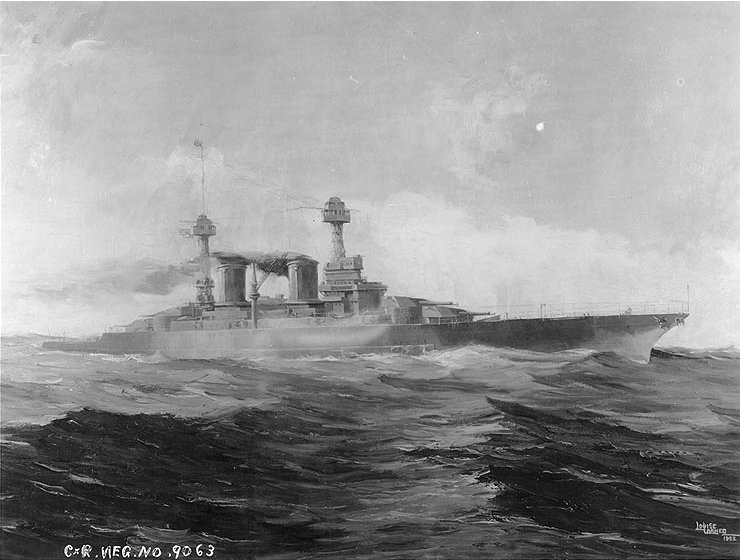
Artist impression of the Lexington-class, final configuration.
For a massive fleet in 1917, the USN still did not have any battlecruiser in service. The reasons were multiple, but first, the isolationism policy in peacetime dictated series of ships considered fit for defensive actions, not offensive ones. The battecruiser concept was more offensive, and on top of that, made for relatively short range swoops due to fuel consumption, fit for areas such as the European North Sea, and not for long range operations as thought by the USN. Therefore only the Royal Navy (which generated the concept) and Germany considered them seriously, as it was unthinkable that one navy could have some and not the other. The two rival lineages will culminate with the HMS Hood in UK and the Mackensen class in Germany. Design of the hood started in 1916, before the battle of Jutland, and was revised several time afterwards, delaying completion of the first ship. The influence of USN thinking about battlecruiser design was quite important. They were impressed with it. The British Admiralty long hesitated between a fast battleship and a pure battlecruiser design, ending with a sort of in-between.
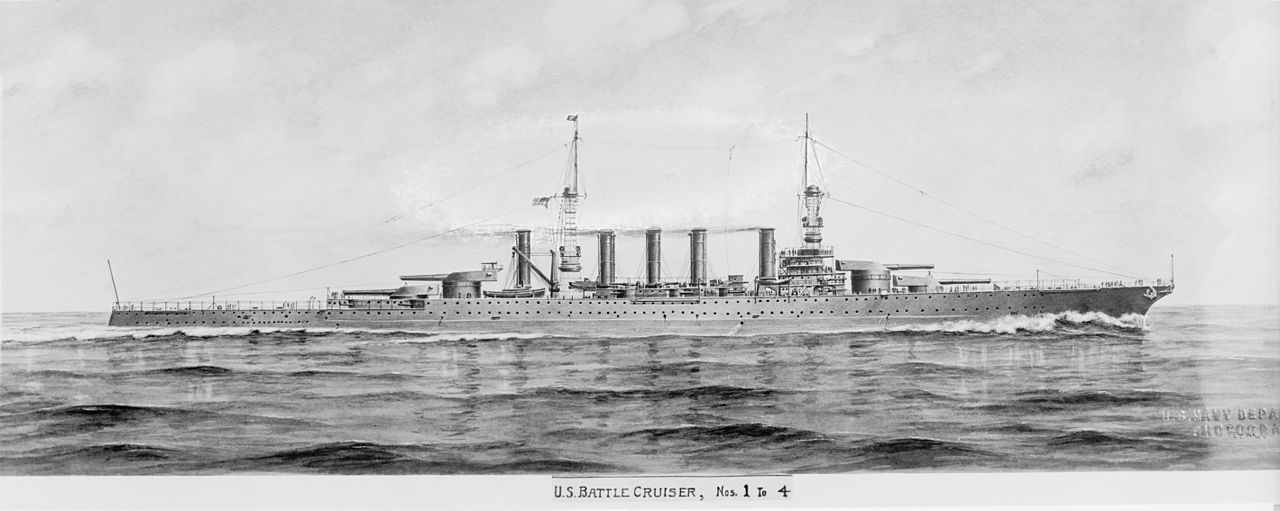
USS Lexington – original configuration 1916
One motivator was the arrival of the Kongo-class battlecruisers on the scene, in the Pacific. However it took opne more year to C&R to materialize a frst design, some sort of fast Pennsylvania class with 8x 14 in guns. However political weather was still not favourable to battlecruisers. The USN already estimated the Congress did not authorized enough battleships and prioritized them. This started to change in 1914, and at last in October, president W. Wilson authorized the famous ten “standard” battleships and also crucially, six battlecruisers. The race was on.
However at that stage, the initial design was planned to be ibe part of a 35-knot (40 mph) scouting force, support the battle fleet and also comprising the Omaha class cruisers and Wickes class DDs. However as the war progressed, like in UK, priority was given to building more merchant ships and anti-submarine warfare destroyers. Laying the keels was delayed but it left time to designers to refine the concept, to the light of the first battlecruisers in combat. Finally the CC1 to CC6, also called Lexington, Constellation, Saratoga, Ranger, Constitution, and United States were a development of 10,000 tons cruisers designs.
The initial, four-funneled 1916 configuration, called for ten 14″/50 caliber guns in four turrets, two lower twin and two upper triple. Indeed, strangely, the compromise not was to reduce the size of the innermost barbettes to allow more room for the massive powerplant to fit in, also a concern when designing the Hood, nor to reduce top-weight to gain stability, but to reduce the outermost barbettes, helping to reduce the hull’s section fore and aft, taking in account the space needed to accomodate ASW protection and compartimentation. Armor however was reduced and despite tier great size, these ships only displaced 34,300 long tons (34,900 t) for a speed of 35 knots. They were impressive nevertheless and technically challenging, with a long, narrow hull causing concerns for longitudinal strenght, heavy weight of main turrets and guns, not enough room for the boilers under the armored deck and many funnel uptakes, no less than seven, including in pairs.
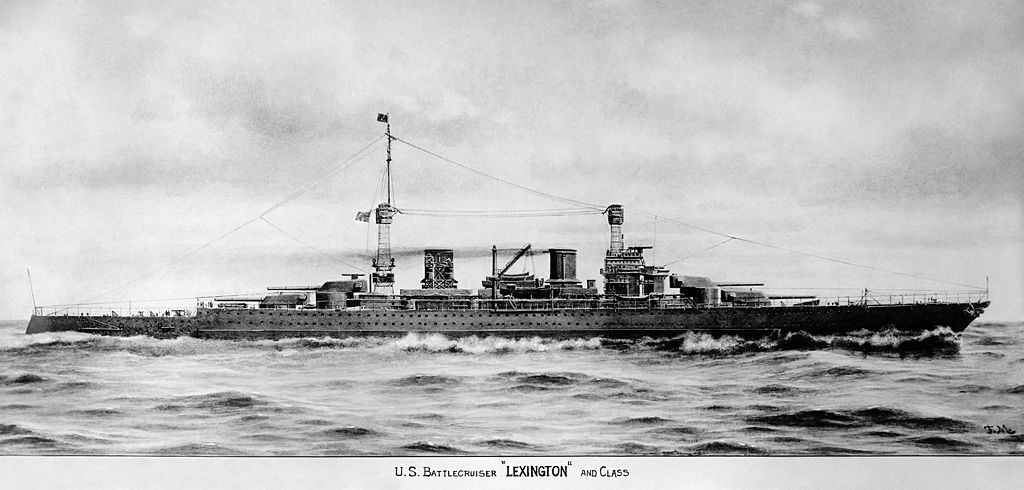
USS Lexington – final configuration 1919
Naval Constructor R. H. Robinson made careful analyses of strength, buoyancy and stresses expected in service and made several recommendations. After the battle of jutland and British design work on the Hood, this started to change. The final design work was put on hold but restarted in 1918 with the help of Stanley Goodall from the Hood’s design team, to C&R. The design started to change dramatically. Eventually, four above-water torpedo tubes were fitted, the width was extended to maximize ASW and belt protection, while it was increased to 7 inches (180 mm). Boiler technology allowed to reduced them to 16 and funnels to two, with massive truncations, and displacement rose to 43,500 tons, making them even heavier than the projected South Dakota class. They would have been the largest warships ever built for the USN before the Iowa class in 1944.
In the wake of the Washington treaty
The South Dakota and Lexington classes were no longer needed in 1919-1920 as the war came to an end. Aside the prevalent pacifism mood of the time and the Congress wary of further spending, Washington eventually endorsed the initiative of a global naval ban, a well-received initiative in some political circles due to the huge financial strain taken by this race in many nations impoverished by the war. Japan perhaps was the less happy with this decision, but eventually would conform to it. This American initiative was one of the very first armament reduction treaty. The Harding administration called the Washington Naval Conference during November 1921 and settled the matter between former allies, including a Nine-Power Treaty about China.
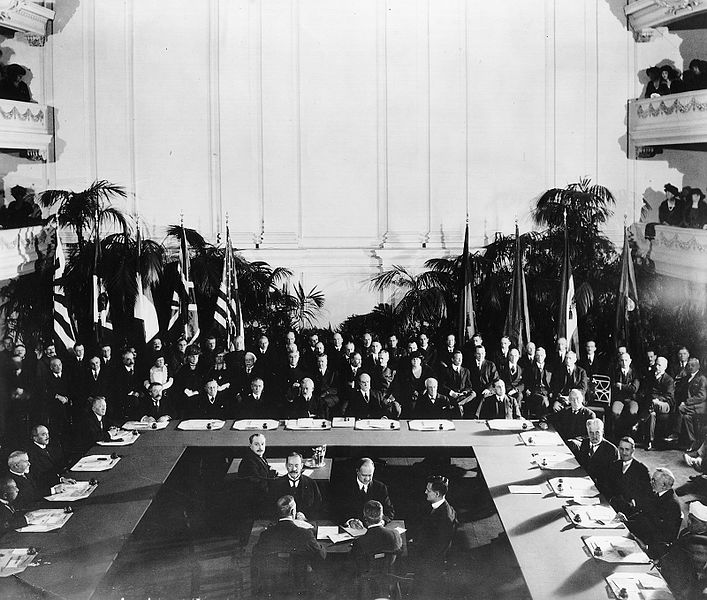
The measure taken would of course hit the previous Wilson’a administration grand plan of building 50 capital ships. It imposed a ten-year pause or “holiday” of the construction of capital ships, later prolonged by the London conference in 1930. It also imposed a simple ratio of tonnage, limits to capital ship tonnage and secondary vessels, known as 5:5:3. In addition it imposed a world ratio between fleets of 5/5/3/1.75/1.75. This barely satisfied both the leading fleets, the USN and RN, Italy, but angered both France and Japan. The first wanted a larger fleet to cope with a sizeable Colonial Empire (which Italy lacked), while the second had grand ambitions in Asia and wanted no less than parity with the USN and RN. The Royal Navy’s admiralty also was concerned about her need simultaneously maintaining a fleet present in the Mediterranean, Asia, North sea and Atlantic. Germany of course was out of this, submitted by the Versailles treaty’s much more drastic limitations.
The result had several consequences: The Mahanists and “falcons” saw the dream of a very large fleet fo the Pacific and another in the Atlantic, able to cope with any potential threat in both areas, faded away. Concrete result was the scrapping of the whole pre-dreadnought fleet (but the Mississipi class, sold to Greece) and the first three dreadnought battleships classes (But USS Utah of the Florida class). Indeed there were two areas of tolerances not to scrap a battleship: Disarmed, with the armour partially scrapped, and converted in any role, from depot ship to naval barracks, training vessel, or target ship. The second option, chosen by most navies, was the conversion as an aircraft carrier. The option was followed by the USN for the two most advanced ships of the Lexington battlecruiser class (see later).
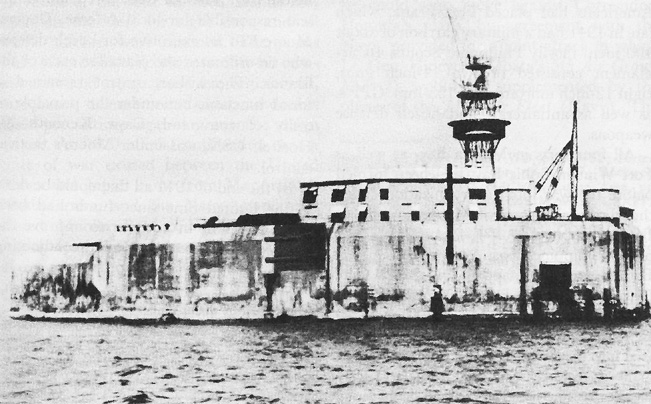
El Fraile Island, aka fort Drum, the “concrete battleship” which defended Manila harbour.
Another self-inflicted limitation by Article XIX of the Treaty concerning Britain, Japan, and the United States forbade new fortifications or naval bases in the Pacific Ocean. It was seen essentially as a conciliation gesture for Japan, but did not stopped the USN to improve existing fortifications, in the case of the Philippines, former Spanish fortifications. One famous example was the “Concrete battleship” of El Fraile Island near Manila. The overall consequence of USN Battleship design was a pause, allowing to concentrate on other aspects instead, like cruiser, destroyer, submarine and aircraft carrier design and operation.
There were limited modernizations however, more so after the crash of wall street, but nothing on the scope of the New Mexico class until WW2. There were little examples to draw inspiration from for USN engineers, but the Hood, and the Nelson class which were exceptions to the treaty. The 1929 Deutschland class was so compromised it escaped all classifications and remained an object of curiosity.
German rearmament soon relaunched capital ship design in Europe though, France answering the Deutschland class, later German rearmament, and the Anglo-German naval treaty in 1935 by restarting construction with the Dunkirk class, followed by the German Scharnhorst class, Italy’s Litorrio’s class. Soon the Royal Navy not to be undone lanched the King Georges V class when the treaties expires. The USN next generation of battleships, the North Carolina class would appear at a later date, drawing from many recent developments.
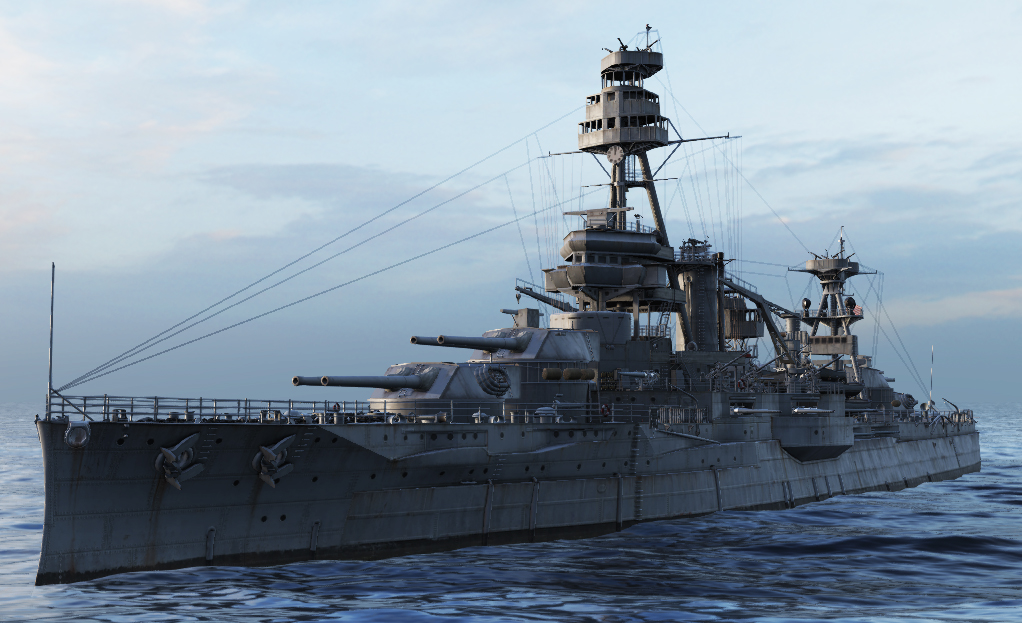
Rendition of USS New York in 1930
Into the Storm: Modernized Dreadnoughts 1942-45
Although it is a bit off-topic it is important to note the fate of these classic dreadnought built before, during and after the great war until Washington. The Pearl Harbor attack in December 1941 erased in one swoop the Pacific fleet, or so it was thought at the time. The importance of aircraft carriers has not yet been well integrated. The attack on Taranto in 1940 and the Japanese one this fateful day shown already this potential, but the old guard of the USN considered the loss as a very serious one for further actions in the Pacific. But it was not such a catastrophe, partly due to unexpected luck: Conservative and prudent admiral Kurita’s refusal of a third wave, targeting the fuel tanks of the fleet was one of these, added to the providential absence of the three aircraft carriers.
Later, only two of the vessels hit in the “battleship row” were terminal constructive losses. All the other battleships, sinking at a moderate depht, could be refloated and sent to a drydock for repairs, but also reconstruction, sometimes very radical. The latter, only applied to the New Mexico class because of budgetary constraints, was at last realized on these survivors, and many lessons of the air war prevalent in the Pacific made them reaching a new status, of AA platforms and artillery support vessels in amphibious operations. For the remainder of the war, they rarely met other Japanese battleships, while most were sunk by the new generations of threats, by air and submarines. This did not prevented the USN to order three more classes of fast battleships during the war, alongside many other constructions, still keeping faith in the capital ship.
For more informations, wait for the upcoming WW2 USN Battleship post.
Sources- Read More
Conway’s all the world’s fighting ships 1860-1905 and 1906-1921
Conference on the Limitation of Armament
Popular Mechanics 1930 over the post-washington fleets
American Heavy Metal: “Dreadnought” Battleships, 1915
USNI – The South Carolina sisters
List of USN BBs on Hazegray
USN Battleships with the grand fleet
//www.historytoday.com/archive/sinking-maine
//ospreypublishing.com/us-navy-dreadnoughts-1914-45
//www.militaryfactory.com/ships/dreadnought-battleships.asp
//fr.naval-encyclopedia.com/1ere-guerre-mondiale/us-navy.php#cuirasses
//en.wikipedia.org/wiki/Standard-type_battleship
//en.wikipedia.org/wiki/Lexington-class_battlecruiser
Nomenclature of USN pre-dreadnought Battleships
USS Texas (1891)
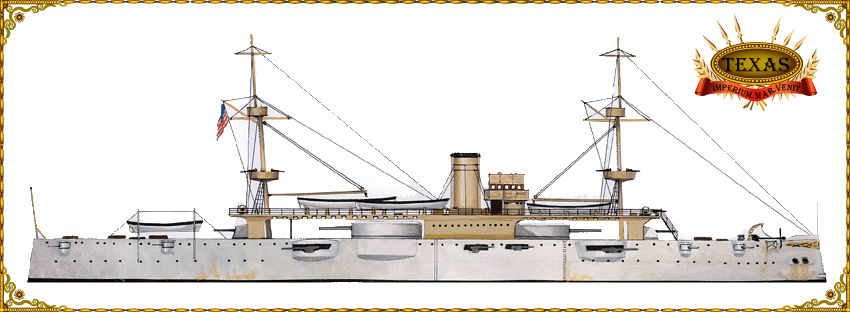
Texas in 1898, shortly before being repainted in dark gray. (1/350)
The USS Texas, not known as “BB” (“Broad Battleship”), like following ships was the US Navy’s first battleship. Before there was the Demologos of 1814 (in wood), the Old Ironside of 1860 (mixed construction), the Monitor of 1862 (first all metal monitor). She was in any case the first “pre-dreadnought” of the US Navy. In addition to USS Maine, 25 more will follow until 1906.
Relatively small (6100 tons), considering Yard’s still limited industrial capabilities and Congress limitations, she was built in Norfolk, in the brand new basin of this large naval base of the Atlantic. She inaugurated a turret arrangement in echelon, quite fashionable at that time, and different from that adopted on twin turret monitors, an areas the USN had great experience. Moreover, the genesis of the Texas was quite complex. For budgetary reasons, she was initially classified as a second-class line vessel, and no less than 13 projects competed. British shipyard John Barrow eventually obtained the contract and created the blueprints, but the ship (partly with British supervision) was built in Norfolk. Work started in June 1889 and the Texas was completed in August 1895.
Considered too small for her large guns, too heavy to be in a turret, she served as a test run for USS Maine. Their range and especially their angle of fire was quite small. Nevertheless, Texas fought at the battle of Santiago, as part of the blocking squadron in the port of the same name. In 1911 she was placed on reserve, modified and recommissioned as a target ship, USS San Marcos. She survived many firing sessions for the new dreadnoughts and it appears that her hull was still stationed at Norfolk, used as a floating depot until 1950.
USS Texas specification
Displacement: 94.13 x 19.53 x 6.86m
Dimensions: Standard 6,135t, 6,665 FL
Propulsion: 2 propellers, 4 VTE machines, 8600 hp. and 17 knots max.
Amour: belt, barbettes, 203 turrets, 305 mm blockhouse; Crew 508
Armament: 2 guns of 305, 6 of 152, 12 of 37 mm, 6 mit. 12.7 mm AT, 4 TLT 356 mm SM.
Crew: 305
USS Maine -ACR-1 (1896)
Three times it was a ship that dragged the US into a war. The first example was the explosion of USS Maine in the port of Havana in 1898. The second example was the torpedoing of the Lusitania in 1917, which carried American citizens on the old continent, and the third example, closer to us, when the destroyer USS Maddox was “attacked” in 1965 by North Vietnamese torpedo boats in the Gulf of Tonkin.
Of these three episodes, the second was a well-exploited error, the two others had in common to have been business assembled from scratch (In 1965, the crews of the two destroyers ventured on order in North Vietnamese waters did not The CIA and the press have done the rest, but the CIA and the press have done the rest of it.With the budget that it lacked, voted by the Congress, President Johnson was fully engaged in the Viet-Nam war. The case of Maine for its part remains a half-enigma: Because if we ignore the real cause of its destruction (boilers, torpedo, ammunition?), The ground was prepared in advance to exploit this accident and make a sabotage , a deliberate attack of the Spaniards, at the origin of the “Splendid little war”.
Technically speaking, Maine was the second battleship of the “New Navy”. The monitors were in a particular category. It was quite different from Texas, though its two turrets were staggered. In addition, they were double turrets, and parts lighter than the standard caliber of 305 mm, the cruiser-battleships, 254 mm. This reduction of size allowed to group two pieces in a single turret and thus to increase the firepower. Moreover, after Maine, all American battleships adopted double turrets, while returning to the standard caliber. Maine was slimmer and heavier (800 tons more) than Texas, he was also very different in silhouette, less massive, and had better clearance for his pieces. He was also the last to keep this singular arrangement of turrets.
Started in 1886 and completed in 1895, she was originally designed as an armored cruiser, inspired by the Brazilian Riachuelo built in Britain. But the project was modified after launch, and nine years after being put on hold, she was completed as a battleship. Her 6-in secondary guns were distributed in barbettes at the bow and stern and the main deck under shields. The tertiary 57-mm and 47-mm rapid-firing anti-TB guns were partly on the main deck and armored tops.
USS Maine, accepted for service on September 17, 1895, was sent to Havana on January 24, 1898, as a means of pressure on Spanish authorities during the insurrection, which began on February 24, 1895, reaching its climax. The ship exploded on February 15, with 222 deads, for reasons still obscure (but not for the then “investigators” concluding of a mine), war was declared April 25, with a retroactive declaration for the 22.
USS Maine Specifications
Displacement: 6682t standard, 7200 tons FL
Dimensions: 97.23 x 17.37 x 6.55m
Propulsion: 2 shaft 4 VTE engines, 9000 hp, 17 knots max.
Armor: belt, barbettes 8 in (203 mm) turrets, 9 in (254 mm) CT;
Crew: 374
Armament: 4 x 254, 6 x 152, 7 x 37 mm, 8 x 12.7 mm AA, 4 x 356 mm TT.
Indiana class (1893)
USS Indiana, Massachusetts and Oregon, were started in 1891 and completed in 1895-96. These battleships were the successors of Maine and Texas, and the first class of three ships of the US navy. Not very successful because of their limited movement, they were veterans of the war against the Spaniards in 1898. Modernized in 1909, their funnels had been raised while they adopted a corbel mast fitted aft. Their low speed meant they saw little action during the Great War, ending as target ships in 1920 for dreadnought gunnery practice. USS Oregon, however was for a time preserved, and used as armored ammunition carrier, participating in the reconquest of Guam in 1944. She was eventually lost in a typhoon and sold in 1956 to shipbreakers.
Indian class Specifications
Displacement: 10,288t, 11,688t FL
Dimensions: 107 x 21,10 x 7,3m
Propulsion: 2 shaft TE, 6 boilers, 9000 hp. 15 knots.
Armour: 457mm belt, 431mm barbettes, turrets 38 mm, blockhouse 230 mm.
Armament: 4 x 330mm, 8 x 203 mm, 4 x 152 mm, 20 x 57mm, 6 x 37mm, 6 x 457mm TTs.
Crew: 580
USS Iowa class (1896)
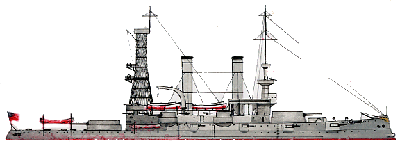
USS Iowa
The USS Iowa had two 12-in twin turrets and four 8-in twin turrets. She derived closely from the previous Indiana except that she returned to a smaller artillery caliber, but with faster international standards. Originally her armament also included six 4-in (110 mm) on the superstructure and the twenty 6-pdr (57 mm) fast firing barbette guns.
In 1898, USS Iowa fought in the Battle of Santiago de Cuba, having an easy hand against the Spaniards. She was modernized in 1909, receiving a rear lattice mast, new 12-in mounts, while most of her 6-pdr guns were replaced by four 3-in AA. Her TTs were also removed. She took part in escorts missions from 1917 to 1918. After the war, she was reclassified as a Coastal Defense ship in 1919, and then was converted into a radio-guided target ship, the first of her kind in the world, sunk in 1923.
Iowa Specifications
Displacement: 11 410t, 12 647t FL
Dimensions: 110.47 x 22 x 7.3 m
Propulsion: 2 shaft VTE, 5 boilers, 11,000 hp, 16 knots
Armor: 457mm belt, 431mm barbettes, turrets 38 mm, blockhouse 230 mm.
Armament: 4 x 305 mm, 8 x 203 mm, 6 x 110 mm, 10 x 57mm, 4 x 37mm, 4 x 76 mm AA.
Crew: 650
Kearsage class (1898)
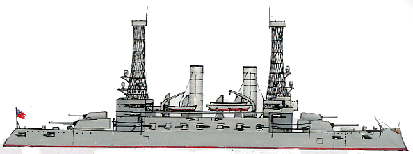
The two battleships of the Kearsage class had as main originality to possess their main and secondary parts in superimposed turrets. But the complexity of the integrated ammunition loading wells proved that this solution had no future. In addition they used a hull flush deck, redistributed and thicker armor. Many of the manoeuvring systems were electric, with total onboard power of 350 KW, a world record. Originally their armament included in addition to their 14-in guns (330 mm), four 8-in (203 mm), fourteen 5-in (127 mm) distributed in lateral barbettes on the first battery bridge and of QF 57 mm guns on the open upper battery bridge and on the flanks, reinforced by eight 37 mm on the superstructures.
She was completed by four lateral torpedo tubes above the waterline. Criticized as bad shooting platforms, they were modernized in 1909-10: Their turrets were replaced by more modern and lighter models, the military masts were removed, replaced by lattice masts, the torpedo tubes were removed, while most of the 57 mm mounts were also removed. Boilers were also replaced. After a smooth service, escorting convoys, USS Kentucky was scrapped in 1923 and Kearsage continued her career until 1955 as a floating crane.
Kearsage Specifications
Displacement: 11,540t, 12,850t FL
Dimensions: 114.40 x 22 x 7.16m
Propulsion: 2 shaft VTE, 5 boilers, 10,000 hp. 16 knot max.
Armor: 420mm belt, 431mm barbettes, turrets 38 mm, blockhouse 230 mm.
Armament: 4 x 330, 4 x 203, 14 x 127, 20 x 57, 8 x 37, 4 x 457mm TTs.
Crew: 680
Illinois class (1898)
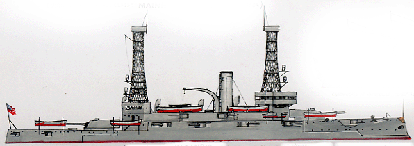
The 3 battleships of this class, USS Illinois, Alabama, Wisconsin, were launched in 1898 and entered service in 1901 and 1902. They received two lattice masts during their 1910 overhaul, as well as new turrets while four 3-in guns (76 mm AA) replaced their original fourteen old 6-pounder (37 mm). USS Illinois served until 1955 under the name of Prairie State from 1941, since 1922 as a utility ship, while Alabama served as a target.
Illinois Specifications
Displacement: 21,825t, 23,033t FL
Dimensions: 160 x 26,9 x 8,6m
Propulsion: 4 shaft VTE, 12 Babcock and Wilcox boilers, 28,000 hp. and 20.75 knots max.
Armor: 280 mm belt, 250 casemates, 250 mm barrels, 305 mm turrets, blockhouse 292 mm.
Armament: 10 x 305 mm, 14 x 127 mm, 4 x 76 mm, 2 x 533 mm TTs.
Crew: 1001
Maine class (1901)
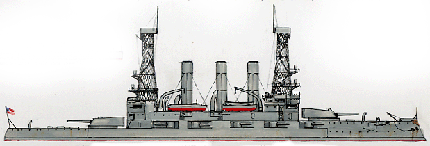
The Maine class counted USS Maine, Missouri, Ohio. The first took the name of the famous battleship of 1897 that hit a mine in the port of Havana in 1898 and rushed the US into a conflict with Spain. They innovated by their dimensions and their tonnage more important, their 12-in guns were faster, and they had a new type of armor allowing smaller thickness. The loading system and the poor tightness of the pedestals gave the gunners some trouble: The Missouri almost exploded as a result of a flashback that fired gargles spreading through the ammunition chamber.
The arrangement of the turrets was therefore profoundly modified. This new configuration was tested in combat: The British monitor HMS Raglan was equipped with one of them and fought the Turkish battle cruiser Yavuz Sultan Selim in January 1918 (The Raglan was sunk). Fast, but subject to the blades in case of heavy weather, these battleships were modernized by adopting poles. USS Maine was equipped with 12 new boilers. Their war service was uneventful and they were removed from service in the early 1920s.
Specifications
Displacement: 11410t, 12647t FL
Dimensions: 110,47 x 22 x 7,3m
Propulsion: 2 shafts VTE, 5 boilers, 11,000 hp. 16 knots.
Armor: 457mm belt, 431mm barbettes, turrets 38 mm, blockhouse 230 mm.
Armament: 4 x 305mm, 8 x 203mm, 4 x 152mm, 20 x 57mm, 6 x 37mm, 6 x 457mm TTs.
Crew: 650
Viginia class (1904)

Succeeding to the Maine, the Virginia class reintroduced the principle of superimposed turrets experimented with Kearsage. It allowed to add secondary guns of 8-in (203 mm) added to those of 6-in (152 mm). In addition their hull was flush-deck, and their greater dimensions allowed a better habitability. The class included the USS Virginia, Nebraska, Georgia and New Jersey, Rhode Island of the second group. Their displacement was 3,000 tons higher, and their speed increased from 18 to 19 knots. These five ships received corbel masts and a gray livery in 1910. They were all stricken in 1923 and used as targets or broken up.
Specifications
Displacement: 14 950t, 16 090t FL
Dimensions: 134,5 x 25,42 x 7,24m
Propulsion: 2 shafts VTE, 12 boilers Babcock and Wilcox, 19,000 hp. 19 knots max.
Crew: 812
Armament: 4 x 305, 8 x 203, 12 x 152, 12 x 76, 12 x 47, 2 x 37, 4 x 533 mm sub TTs.
Connecticut class (1905)

The pre-dreadnought battleships class comprised the USS Connecticut, Louisiana, Vermont, Kansas, Minnesota, and New Hampshire. They were built between 1903 and 1908 and armed with a mixed classic 12-inch (305 mm) twin turrets, but also two twin turrets of 8-inch (203 mm) guns and 7-inch (178 mm) guns in barbettes. This arrangement answered to the belief fast-firing guns were preferrable, and that main turrets could not be placed in the wings or superfiring positions. This “semi-dreadnought” configuration was soon made obsolete by the advent of all-big-gun battleships or “Dreadnought”.
These ships had active careers, taking part in Great White Fleet world cruise in 1907–1909 and from 1909 they were the workhorses of the US Atlantic Fleet. Unrest broke out in several Central American countries and they were involved in police operations such as the intervention in the Mexican Revolution and landing at Veracruz in April 1914.
Before 1917, the Connecticut-class ships were used as training vessels, and patrolled the coast, making convoy escorts by late 1918. In September USS Minnesota hit a mine laid by the German U-boat SM U-117. After the war ended they carried the boys back home, and resumed their training career. But with the 1922 Washington Naval Treaty, all six ships were discarded and sold for scrap.
Specifications
Displacement: 16,000t, 17,600t FL
Dimensions: 139,10m x 23,42m x 7,47m
Propulsion: 2 shafts, 12 boilers Babcock and Wilcox, 16,500 hp. 18 knots max.
Crew: 880
Armament: 4 x 305mm, 8 x 203, 12 x 178, 20 x 76, 12 x 47, 4 x 37mm, 4 x 533 mm TT.
Mississippi class (1906)

The Mississippi class authorized in the 1903 naval budget comprised the USS Mississippi and Idaho. They were the last American pre-dreadnought, and somewhat “semi-dreadnoughts” with their powerful secondary artillery. Indeed their main, intermediate, secondary, and tertiary gun sizes configuration became obsolete before completion. In battle it would have been difficult to identify the splashes and correct fire indeed. In addition, this was a supply nightmare.
The Mississippi class were virtual repeats of the Connecticut class, based on lessons learned in the Spanish–American War. However soon the Russo-Japanese War, war games, and experimentation demonstrated better solutions. Large guns became more accurate and made rapid-fire intermediate artillery superfluous. The “all-big-gun” concept was on its way and already the South Dakota were laid down even before the Mississippi and Idaho where completed. They were were also smaller than preceding classes by order of the congress, ans a cost-effective measure. To the dismay of naval thinkers such as Dewey and Mahan, which militated for many small battleships as a strategically sound way to establish naval power. The reduction in length also impacted the engine size, and fuel capacity. So they ended slower and short-ranged, but also deficient in steering, stability and sea keeping.
They served from 1908 to 1914, and were sold to Greece, renamed Kilkis and Lemnos (An article has been written about the Kilkis class battleships and this part of their secondary career.
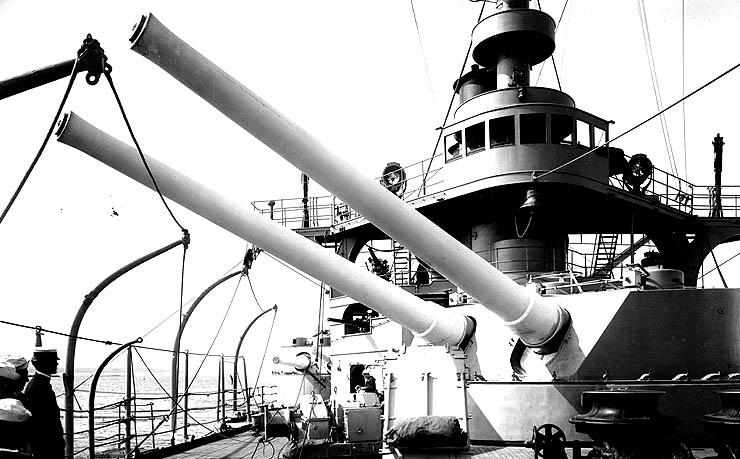
Specifications
Displacement: 16,000t, 17,600t FL
Dimensions: 139,10m x 23,42m x 7,47m
Propulsion: 2 shafts VTE, 12 boilers Babcock and Wilcox, 16,500 hp. 18 knots.
Crew: 880
Armament: 4 x 305mm, 8 x 203, 12 x 178, 20 x 76, 12 x 47, 4 x 37mm, 4 x 533 mm TTs.
Nomenclature of USN Dreadnoughts
South Carolina class (1908)

These first American dreadnoughts were considered hybrid ships, of dimensions and construction close to those of the classic battleships, while having a monocalibre armament. For budget reasons, the Senate demanded that its tonnage remain limited to 16,000 tons, with a speed of 16 knots sufficient compared to future battle cruisers planned. But these compromises caused the USS South Carolina and the USS Michigan to be relegated to the pre-dreadnoughts category, and not much fire.
Specifications
Displacement: 16,000t, 17,617t FL
Dimensions: 138m x 24,5m x 7,5m
Propulsion: 2 shaft VTE, 12 boilers, 16500 hp. 18.5 knots.
Armor: 250mm belt, 250 mm barbettes, turrets 305 mm, blockhouse 305 mm.
Armament: 8 x 305mm, 22 x 76mm, 2 x 533mm TTs SM flanks.
Crew: 870
Delaware class (1909)

The dreadnought class battleships of the Delaware class, launched in 1909 and completed in 1910, can be consecrated as the first “real” of the US Navy, so much the South Carolina they succeed are, apart from their armament monocaliber, close to the old battleships . They are the first of a tonnage, of dimensions, and especially of a speed more in conformity with this type of building. They also received two additional 305 mm pieces, bringing the total to 10 as the British HMS Dreadnought.
However they were critical for their low barbettes, putting the effectiveness of these secondary guns at the mercy of sea spray. Drawn with the classic simple masts, the latter were converted to their completion in cranes for the lifeboats. Their corbel masts were a recurring feature of American warships until the 1940s. They served in the Atlantic during the war, and were reformed in 1924 and 1931.
Specifications
Displacement: 20 400t, 22 060t FL
Dimensions: 158,20m x 26m x 8,3m
Propulsion: 2 Curtiss turbines, 14 Babcock and Wilcox boilers, 25,000 hp. 21 knots.
Crew: 933
Armament: 10 x 305mm (5×2), 14 x 127mm, 2 x 533 mm TTs.
Florida class (1909)

The class battleships Florida, USS Florida and Utah, very close to the Delaware, were distinguished by their last turrets vis-à-vis. They were slightly better shielded. during the crisis of Vera Cruz, in 1914 they landed 1000 marines. During the war, they were affected in the Atlantic, operating from Ireland. In 1930, as a result of the London Treaty, they were disarmed in 1930, the Florida being wiped out in 1931. The USS Utah becoming a target ship, then training. Based in Pearl Harbor on December 7, 1941, he was torpedoed and bombed by the Japanese air force and exploded.
Specifications
Displacement & Dimensions 21,825t, 23,033t PC_160x26,9×8,6m
Propulsion 12 boilers Babcock and Wilcox, 4 propellers, 28,000 hp. and 20.75 knots max.
Shield 280-230mm belt, 250-203-127, casemates, barbettes 250, turrets 305, blockhouse 292.
Armament 10 guns of 305mm, 14 of 127mm, 2 TLT of 533mm.
Crew 1001
Arkansas class (1911)

The USS Wyoming and Arkansas were part of the president’s personal plan to see the heavy units of the fleet in 1910 from 305 to 355 mm. Three projects were proposed to him, a building bearing 12 pieces of 305, another bearing 8 pieces of 355 mm and a last bearing 10 pieces of 355 mm. However, many infrastructures were not yet adapted to ships capable of operating a superior artiellerie. Provisionally, it was decided to opt for an arrangement of 305mm pieces.
As a result, both units had to carry one turret more than the previous Florida. We also tried a hull “flush deck”, which did not prove particularly interesting. The USS Wyoming and the USS Arkansas, completed in 1912, served during both wars (see Arkansas 1941), and were stricken in 1946 and 1947.
Specifications
Displacement: 26,000 t, 27,240 T FL
Dimensions: 171.3m x 28.4m x 8.7m
Propulsion: 2 shafts Parsons turbines, 2 Babcock and Wilcox boilers, 28,000 hp. 20.5 knots max.
Armor: Belt 280, Battery 280, Barbets 280, turrets 305, blockhouse 292mm.
Armament: 12 x 305 mm, 21 x 127mm, 2 x 533mm (SM flanks) TTs.
Crew: 1063
New York class (1912)

The USS New York and the USS texas were the last battleships completed before the war. They adopted a new 14-in (356 mm) artillery instead of the traditional 12-in in five twin turrets in the axis, like what was done elsewhere, although this central turret was not located between the two funnels, as on the French, Japanese, British or Italian Ships, but aft. The USS texas was not present at Pearl Harbor but was operating on the Neutrality Patrol, and in December she was resting in Maine, at Casco Bay. She multiplied convoy-escort missions, was covering Operation Torch, D-Day, Operation Dragoon, plus the Battles of Iwo Jima an Okinawa. For her part, USS New York was also assigned to the Atlantic, modernized in 1942. She served intensely during the war and was was disarmed and sold for scrap in 1947. USS Texas was purchased by the state of Texas and converted as a museum ship. She is the only example of a surviving dreadnought today.
Specifications
Displacement: 26,000 t, 27,240 T FL
Dimensions: 171.3m x 28.4m x 8.7m
Propulsion: 2 shafts Parsons turbines, 2 Babcock and Wilcox boilers, 28,000 hp. 20.5 knots max.
Armor: Belt 280, Battery & casemates 280, turrets 305, CT 292mm.
Armament: 12 x 305 mm, 21 x 127mm, 2 x 533mm (SM flanks) TTs.
Crew: 1063
Nevada class (1914)
The two Nevada-class were the first Standard-type battleships of the U.S. Navy, and so the first to use triple main turrets and obey several specifications in term of speed, radius and other elements (see earlier). Nevada (BB-36) and Oklahoma (BB-37) ordered in March 1911 set a new stage for armament, armor, and propulsion, and were quite an advanced design on the world stage, specifically tailored for very long range gunnery engagements.
The standard type would later include the Pennsylvania, New Mexico, Tennessee and Colorado classes, all incrementally enhances. They shared the same four main turrets, the new radical “all or nothing” armor scheme (with improved deck armor) and an oil-fired propulsion. This protection was so advanced that it was never really revised after the Battle of Jutland. The Nevadas were quite active during the great war, protecting Allied supply lines until 1918. After Washington’s tonnage cuts they became the veterans of the main Battle Fleet. They were therefore both well modernized in 1927-1929 and benefited from other refits until 1941. Oklahoma was one of the rare total losses, but Nevada was repaired and went on fighting in the Atlantic.
Specifications
Displacement: 27,500 t, 27,900 T FL
Dimensions: 177 m x 26.1 m x 8.7 m
Propulsion: 2 shafts VTE, 12 Yarrow/Bureau boilers, 24,800 hp. 20.5 knots max.
Speed: 20.5 knots (38.0 km/h; 23.6 mph), radius 8000 nm
Armor: Belt: 8–13.5 in, Barbettes: 13 in, Turrets: 5–18 in, CT: 11.5 in, Decks: 3 in, 1.5–2 in splinter
Armament: 10 x 356 mm, 21 x 127 mm, 2x 76 mm AA, 2 x 533 mm (sub) TTs.
Crew: 864
Pennsylvania class (1915)

The Pennsylvania-class comprised ships dubbed “super-dreadnought” battleships, including the USS Pennsylvania and Arizona. They were the second of the standard BBs with four turrets and the “all or nothing” armor scheme, brand new when the US entered the First World War in 1917.
They represented a step forward with two additional 14-inch (356 mm)/45 caliber guns in all triple turrets and better underwater protection. This class was followed by the New Mexico and Tennessee, very close, until the up-armed Colorado class.
Both battleships saw little service in the First World War, partly because of a shortage of oil fuel in the UK whereas most ships were still using coal. In fact only coal-burning USN ships were sent to the European theater. Despite of this, they joined France after the war, escorting the fleet carrying President Wilson for the Paris Peace Conference of 1919. They joined afterwards the Pacific Fleet and were modernized in 1929-1931 like the Nevada and along the same line. Both were in Pearl Harbor in December 1941, Arizona being sunk by a massive magazine explosion and now a memorial but Pennsylvania, which was in dry dock, only received only minor damage and was quickly operational again in early 1943, participating in the Pacific campaign.
Specifications
Displacement: 29,200 t, 31,900 T FL
Dimensions: 185 m x 26.7 m x 8.9 m
Propulsion: 2 shafts Curtis/Parsons turbines, 12 Yarrow/Bureau boilers, 31,500 hp.
Speed: 21.38 knots (39.60 km/h; 24.60 mph), radius 6,000 nm
Armor: Belt: 8–13.5 in, Barbettes: 13 in, Turrets: 5–18 in, CT: 11.5 in, Decks: 3 in, 1.5–2 in splinter
Armament: 10 x 356 mm, 21 x 127 mm, 4x 76 mm AA, 2 x 533 mm (sub) TTs.
Crew: 864
New Mexico class (1917)

Another incremental step over the Pennsylvania, these three dreadnought, New Mexico, Mississippi, and Idaho were the third of the standard series, and basically repeats of the Pennsylvania-class with the same twelve 14-inch (356 mm)/50 battery. However improvements comprised a better secondary battery mostely in casemate and a distinctive clipper bow helping them improving seakeeping, making this secondary artillery less “wet” and more usable by all weather. They also tried an experimental turbo-electric propulsion system but kept the same top speed of 21 knots (39 km/h; 24 mph).
These three ships did little or no service during the great war, being operational too late, and instead served with the Pacific Fleet. By chance in 1941 they joined the east coast for Neutrality Patrols in the Atlantic. Following the Japanese attack they were sent to the Pacific, escorting convoys and later supporting amphibious operations during the Aleutian Islands, Gilbert, Marshall, Mariana, Palau, Philippines campaigns, and fought at the Battle of Surigao Strait on 24 October, the hayday of battleships duels at sea.
Specifications
Displacement: 29,200 t, 31,900 T FL
Dimensions: 185 m x 26.7 m x 8.9 m
Propulsion: 2 shafts Curtis/Parsons turbines, 12 Yarrow/Bureau boilers, 31,500 hp.
Speed: 21.38 knots (39.60 km/h; 24.60 mph), radius 6,000 nm
Armor: Belt: 8–13.5 in, Barbettes: 13 in, Turrets: 5–18 in, CT: 11.5 in, Decks: 3 in, 1.5–2 in splinter
Armament: 10 x 356 mm, 21 x 127 mm, 4x 76 mm AA, 2 x 533 mm (sub) TTs.
Crew: 864
Tennessee class (1919)

The Tennessee class comprised two ‘super-dreadnought’ and standard battleships, the USS Tennessee and California. This was basically a repeat of the New Mexico class, with an improved ASW protection. They also had a better mountings elevation, carried the same main battery and same top speed and general armour scheme. Both were completed well after the end of the great war: Tennessee was launched on 30 April 1919 and California in november, completed in 1920 and 1921. They served in the interwar, receiving a refit and were part of an extensive training program.
Both were in Battleship Row, Pearl Harbo in December 1941. USS California was torpedoed and sunk, Tennessee was bomb-damaged but relatively unscaved. The first has to be was re-floated and repaired but eventually both were completely rebuilt in 1942-1944. It was one of the most thorough reconstruction of a WW1-era battleships perhaps with some QE class ships and Italian dreadnoughts. The two battleships saw very extensive service during the island hopping campaign until the end of the war. Battle records included the Aleutian Islands, Gilbert, Marshall, Mariana, Palau, Battle of Surigao Strait, Lingayen Gulf, Iwo Jima, Okinawa. They survived until 1959.
Specifications
Displacement: 32,300 t, 33,900 T FL
Dimensions: 190 m x 29.7 m x 9.2 m
Propulsion: 4 shafts turbo electric, 8 B&W boilers, 26,800 hp.
Speed: 21 knots (39 km/h; 24 mph), radius 8,000 nm
Armor: Belt: 8–13.5 in, Barbettes: 13 in, Turrets: 5–18 in, CT: 16 in, Decks: 3.5 in
Armament: 10 x 356 mm, 14 x 127 mm, 4x 76 mm AA, 2 x 533 mm (sub) TTs.
Crew: 1083
Colorado class (1920)

The Colorado-class battleships as planned were four, buy ended as three: USS Colorado, Maryland, and West Virginia. The fourth, USS Washington, was 75% complete when canceled under Washington Naval Treaty limitations in 1922. They were the last and most powerful USN battleships before the 1940s North Carolina class and final of the Standards. The only real upgrade were the eight 16-inch guns in twin turrets instead of triple with the ‘lighter’ 14-in calibre. They were also the last twin-turrets battleships of the USN. The next standard of WW2 would adopt the preffered configuration of three triple turrets. The adoption of a larger calibre was the result of the launch of the Japanese Nagato-class battleships.
All three were completed well after WWI, in 1921 and 1923, after being launched in 1920-21. Apart USS Maryland, started in late 1917, the others were laid down after the end of the war, in May-June 1919 and 1920. They barely qualify as “WW1 USN Battleships” but for the design period.
All three battleships saw extensive careers during the interwar. USS Maryland and West Virginia were at Pearl Harbor and while the first escaped with little damage, USS West Virginia was badly hit and sunk. She was raised and repaired but this delayed her re-commissioning compared to her sister-ships. All three were used actively during the 1943-45 USN amphibious operations of the Pacific. USS Maryland and West Virginia fought during the Battle of Surigao Strait, duelling with the IJN capital ships and cruisers.
Colorado class Specifications
Displacement: 32,600 t, 36,000 T FL
Dimensions: 190.27 m x 29.67 m x 9.30 m
Propulsion: 4 shafts turbo-electric transmission, 8 B&W boilers, 29,000 hp.
Speed: 21 knots (39 km/h; 24 mph), radius 6,000 nm
Armor: Belt: 8–13.5 in, Barbettes: 13 in, Turrets: 5–18 in, CT: 11.5 in, Decks: 3.5 in
Armament: 8 x 406 mm, 12/14 x 127 mm, 2 x 533 mm (sub) TTs.
Crew: 1080
South Dakota class (1920)

The South Dakota class battleships were to be the ultimate dreadnoughts built by the US Navy, but the Washington Treaty intervened before theey could be completed. The total was to include 6 ships, the USS South Dakota, Indiana, Montana, North Carolina, Iowa and Massachusetts. Overall, these were a Tennessee class carrying Colorado guns, ie triple turrets of 1-in or 406 mm, formidable armament if any. Moreover, with their displacement of 43,200 tons empty, they followed the ongoing race between Japan and UK. Apart from their large dimensions, these ships would have been recognizable by their four funnels raked into one. The Washington Treaty’s tonnage restrictions and 10-year ban stalled their construction and the ships were canceled in February 1922.
South Dakota Specifications
Displacement: 43,200t, 45,000t FL
Dimensions: 208.50m x 32.3m x 10m
Propulsion: 4 shafts, 12 boilers, 4 turbo-electric turbines, 50,000 hp. 23 knots.
Armor: 420 mm belt, 431 mm barbettes, turrets 38 mm, blockhouse 230 mm.
Armament: 12 x 406, 16 x 152mm, 4 x 76 mm, 2 x 533mm SM TTs.
Crew: 1,190
Lexington class battlecruisers (1920)

Author’s HD illustration, early configuration in 1917.
Among the most extraordinary planned battleships ever planned, the Lexington class were designed after of the Battle of Jutland, and inspired by the early HMS Hood design, and as a result, better protected ships but widely disputed over design issues.
In the end, this quadrature of the circle resulted in very large units, flirting with 60,000 tons. In addition their last design included eight 18-in or 457 mm guns, a new heavy artillery standard also considered by the Japanese and British. Like the South Dakota class battleships, the five Lexington-class battle cruisers (Lexington, Saratoga, Constitution, Constellation, United States) that were to be completed in 1922-23 but canceled due to the Washington Treaty in 1923. The most advanced, the Lexington (“Lady Lex”) and Saratoga were converted into fleet aircraft carriers, an ideal choice because of their large size and speed.
More to come in a dedicated post.
Read More:
Conway’s all the world 1860-1905, 1906-1921
https://www.navistory.com/navis19e.net/pages/guerre_hispano_am/usnavy1898/marine_americaine1898.html



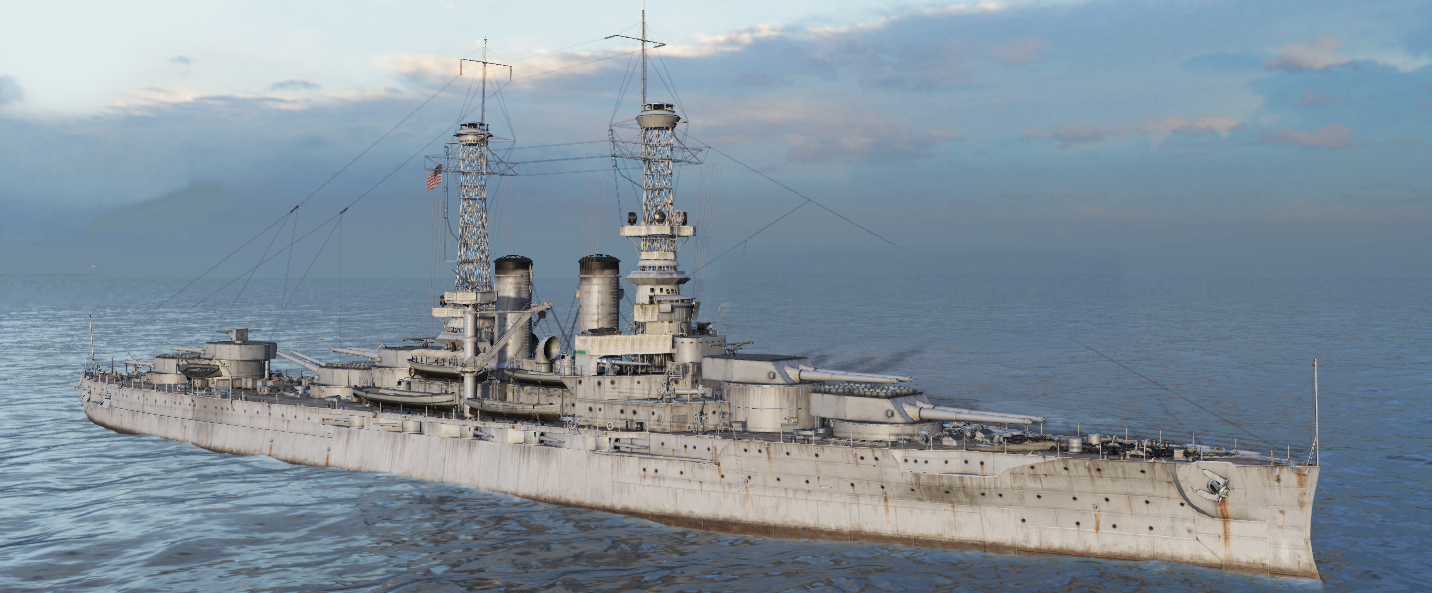
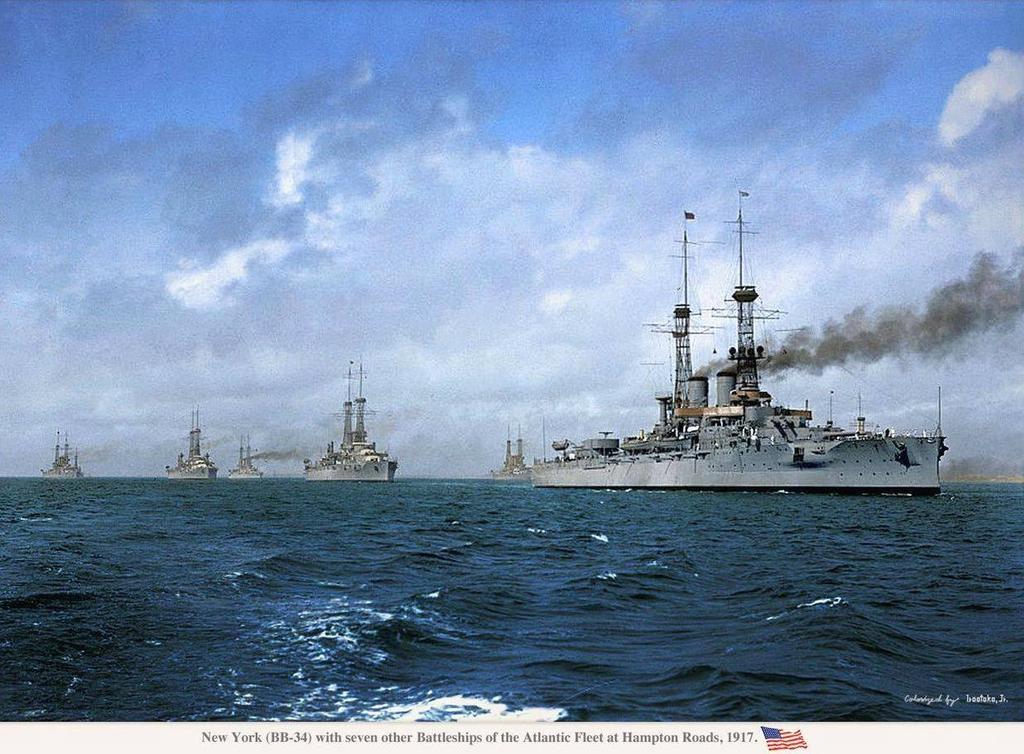

 Latest Facebook Entry -
Latest Facebook Entry -  X(Tweeter) Naval Encyclopedia's deck archive
X(Tweeter) Naval Encyclopedia's deck archive Instagram (@navalencyc)
Instagram (@navalencyc)





 French Navy
French Navy Royal Navy
Royal Navy Russian Navy
Russian Navy Armada Espanola
Armada Espanola Austrian Navy
Austrian Navy K.u.K. Kriegsmarine
K.u.K. Kriegsmarine Dansk Marine
Dansk Marine Nautiko Hellenon
Nautiko Hellenon Koninklije Marine 1870
Koninklije Marine 1870 Marinha do Brasil
Marinha do Brasil Osmanlı Donanması
Osmanlı Donanması Marina Do Peru
Marina Do Peru Marinha do Portugal
Marinha do Portugal Regia Marina 1870
Regia Marina 1870 Nihhon Kaigun 1870
Nihhon Kaigun 1870 Preußische Marine 1870
Preußische Marine 1870 Russkiy Flot 1870
Russkiy Flot 1870 Svenska marinen
Svenska marinen Søværnet
Søværnet Union Navy
Union Navy Confederate Navy
Confederate Navy Armada de Argentina
Armada de Argentina Imperial Chinese Navy
Imperial Chinese Navy Marinha do Portugal
Marinha do Portugal Mexico
Mexico Kaiserliche Marine
Kaiserliche Marine 1898 US Navy
1898 US Navy Sovietskiy Flot
Sovietskiy Flot Royal Canadian Navy
Royal Canadian Navy Royal Australian Navy
Royal Australian Navy RNZN Fleet
RNZN Fleet Chinese Navy 1937
Chinese Navy 1937 Kriegsmarine
Kriegsmarine Chilean Navy
Chilean Navy Danish Navy
Danish Navy Finnish Navy
Finnish Navy Hellenic Navy
Hellenic Navy Polish Navy
Polish Navy Romanian Navy
Romanian Navy Turkish Navy
Turkish Navy Royal Yugoslav Navy
Royal Yugoslav Navy Royal Thai Navy
Royal Thai Navy Minor Navies
Minor Navies Albania
Albania Austria
Austria Belgium
Belgium Columbia
Columbia Costa Rica
Costa Rica Cuba
Cuba Czechoslovakia
Czechoslovakia Dominican Republic
Dominican Republic Haiti
Haiti Hungary
Hungary Honduras
Honduras Estonia
Estonia Iceland
Iceland Eire
Eire Equador
Equador Iran
Iran Iraq
Iraq Latvia
Latvia Liberia
Liberia Lithuania
Lithuania Mandchukuo
Mandchukuo Morocco
Morocco Nicaragua
Nicaragua Persia
Persia San Salvador
San Salvador Sarawak
Sarawak Uruguay
Uruguay Venezuela
Venezuela Zanzibar
Zanzibar Warsaw Pact Navies
Warsaw Pact Navies Bulgaria
Bulgaria Hungary
Hungary

 Bundesmarine
Bundesmarine Dutch Navy
Dutch Navy Hellenic Navy
Hellenic Navy Marina Militare
Marina Militare Yugoslav Navy
Yugoslav Navy Chinese Navy
Chinese Navy Indian Navy
Indian Navy Indonesian Navy
Indonesian Navy JMSDF
JMSDF North Korean Navy
North Korean Navy Pakistani Navy
Pakistani Navy Philippines Navy
Philippines Navy ROKN
ROKN Rep. of Singapore Navy
Rep. of Singapore Navy Taiwanese Navy
Taiwanese Navy IDF Navy
IDF Navy Saudi Navy
Saudi Navy Royal New Zealand Navy
Royal New Zealand Navy Egyptian Navy
Egyptian Navy South African Navy
South African Navy






























 Ukrainian Navy
Ukrainian Navy dbodesign
dbodesign
Very impressive write-up and I learned a lot of new things.
One correction though, USS Texas wasn’t at Pearl Harbor and still exists today as a museum ship.
Thank you for this very informative site. I enjoy your Facebook posts too.
Thanks!
Indeed i dunno where this info came from, i knew the Texas is now a museum ship and it is shown in the article. This old part needed serious rewriting.
Cheers !
To Alex, september 2: in the text it’s correctly said that Texas was not at Pearl Harbor on the day of Japanese raid.
Lots of great info but in dreadful need, like most of these articles , of a trained editor. These things can be painfull to read.
Same problem when you have a website done by a non-speaker. Automatic correcter AI is far from perfect and most of these posts needs to be corrected, too many mispellings and no re-reads.
So far, nobody went to propose any help.
-The webmaster